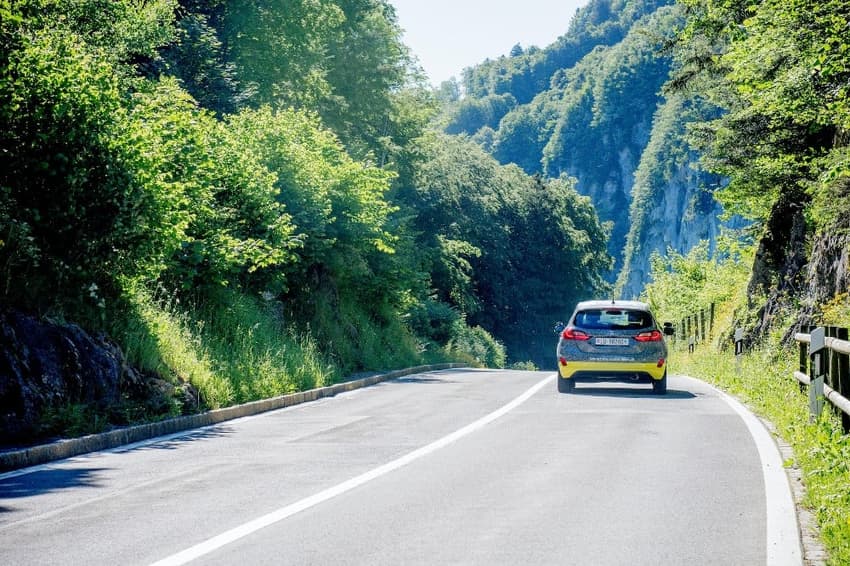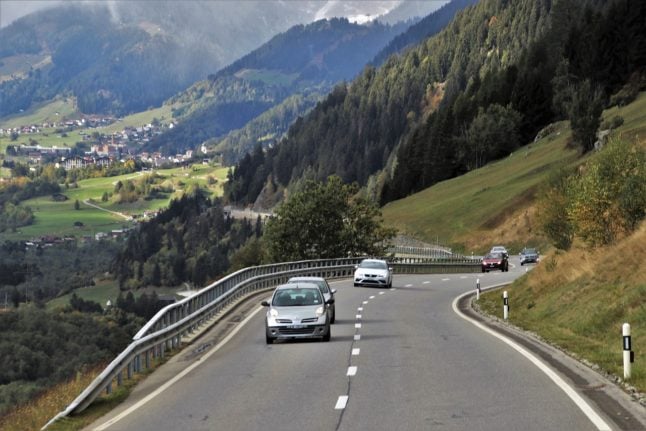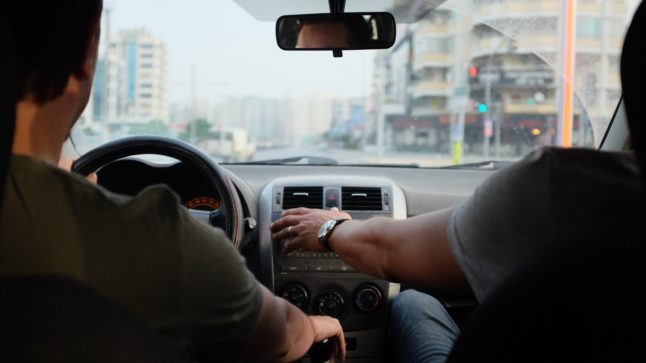EXPLAINED: The dos and don'ts of driving in Switzerland

If you are going to drive in Switzerland (or are already driving here), you should know the road rules that apply to all vehicles. Some of them are pretty much the same as elsewhere in Europe, while others differ.
Get your tyres right
In Switzerland, it is common practice to swap your summer tyres for winter ones come October – but what if you don’t? If you’re looking to save money and hit the road with your winter tyres in the warmer months, then know that this is by no means illegal, but it is strongly discouraged.
In fact, various tests show that winter tyres have a significantly longer breaking distance on both dry and wet roads at higher temperatures when compared to summer tyres. As such, they are generally considered unsuitable for summer due to their rubber compound which reduces traction and driving stability.
Since in Switzerland the driver must be able to control their vehicle in every situation and is legally obliged to equip the car in an operational and roadworthy manner, an accident that’s caused while driving with the wrong tyres can be either wholly or partially rejected by your insurer – and that can cost you dearly.
READ ALSO: When must I change my winter tyres in Switzerland?
Leave your flip flops at the beach
It may come as a surprise that driving barefoot or in flip flops in the summer months in Switzerland is not illegal according to Article 31 of the Road Traffic Act (SVG) – but don’t let that tempt you.
While not prohibited, it is by no means advisable to drive barefoot or wearing loose-fitting shoes as the risk of slipping - especially with sweaty feet - is not only too high but may cost you a fair penny.
If you do decide to drive in shoes that are considered unsuited for driving safely and happen to be in an accident, you will be committing an offence. In addition, your insurance company may determine that you have acted with gross negligence and refuse to cover any of the cost related to the accident.
Pro tip: leave a pair of sneakers (and socks) in your car for times like these.

Drivers on a mountain road. Photo: Julita on Pixabay
No vignette, no motorway
If you are planning to travel on Switzerland’s motorways, you need a special sticker called a 'vignette' with the grace period for not having one ending on February 1st – this also applies to tourists who are only in Switzerland for a short amount of time.
If you don't buy the sticker - which costs 40 Swiss francs within Switzerland - and police stop you, you could be fined 200 Swiss francs. You will also have to buy the sticker in addition to paying the fine.
READ ALSO: Swiss vignette: What you need to know about Switzerland’s motorway charge sticker
Car lights must be on day and night
Unlike in many European countries, you must leave your headlights on when driving in Switzerland during the day. This law, which came into force on January 1st 2014, applies to all motor vehicles, including two-wheelers. Failure to do so will result in a fine of 40 Swiss francs.
Note that Switzerland differentiates between daytime running, low beam, high beam, parking and fog lights, and always ensure you have the appropriate light switched on for the time of day and/or weather.
Don’t drive cars registered abroad
If your friend drives over for a visit from a foreign country and you can’t wait show them around your new home, remember that you – as a person living in Switzerland - are not allowed to drive a car (within Switzerland) that is registered in a different country. This is not possible under customs law since the car is considered imported and must be declared and taxed.
So, even if a friend is kind enough to lend you their car for a few days, it is smarter to just say no. If you are caught by police driving around in a car that is registered abroad, you will be liable to pay a hefty fine at best.
Passengers can be liable for drink driving
If the driver of a car you happen to be in has a blood alcohol level of 0.5 and over, note that you as a passenger may be fined for allowing your intoxicated friend to drive.
In Switzerland, professional drivers, new drivers (driving licence on probation), learner drivers, driving instructors and persons accompanying learner trips, which are mandatory after passing a driver’s test, are subject to an alcohol limit of 0.01 percent.
Warning triangle a must
If you’re hitting the road in Switzerland, you must have a warning triangle in your car all year round. High-visibility vests and first-aid kits are not mandatory, but it is advisable to store those in your vehicle too just in case.
If you happen to be involved in an accident in Switzerland or your car breaks down, drive the vehicle to the nearest curb and set up the red warning triangle behind the car to warn oncoming traffic.

Photo by Orkun Azap on Unsplash.
Don’t look at your phone
Sounds simple enough, right? However, though you are allowed to hold your phone while driving in Switzerland, if you hold it to your ear, text, call or even so much as glance at it, you will be committing a criminal offence and risk paying a 100-franc fine. Police can also withdraw your driver’s licence. It is therefore best to place your phone in the glove department. Out of sight, out mind - well, almost.
Know the right of way when driving on mountain roads
When driving on mountain roads in Switzerland it is important to note that, as a rule of thumb, the ascending vehicle has the right of way. If it is not possible to drive past one another, the descending vehicle must back up unless the ascending vehicle is close to a passing point.
Drivers should also note that heavy vehicles, such as trucks, coaches, and buses, have priority over other vehicles driving both up and downhill. Additionally, coaches have priority over trucks on mountain roads.
If you cross paths with a post bus and neither of you can easily drive past, you must follow the instructions of the bus driver.
Comments
See Also
Get your tyres right
In Switzerland, it is common practice to swap your summer tyres for winter ones come October – but what if you don’t? If you’re looking to save money and hit the road with your winter tyres in the warmer months, then know that this is by no means illegal, but it is strongly discouraged.
In fact, various tests show that winter tyres have a significantly longer breaking distance on both dry and wet roads at higher temperatures when compared to summer tyres. As such, they are generally considered unsuitable for summer due to their rubber compound which reduces traction and driving stability.
Since in Switzerland the driver must be able to control their vehicle in every situation and is legally obliged to equip the car in an operational and roadworthy manner, an accident that’s caused while driving with the wrong tyres can be either wholly or partially rejected by your insurer – and that can cost you dearly.
READ ALSO: When must I change my winter tyres in Switzerland?
Leave your flip flops at the beach
It may come as a surprise that driving barefoot or in flip flops in the summer months in Switzerland is not illegal according to Article 31 of the Road Traffic Act (SVG) – but don’t let that tempt you.
While not prohibited, it is by no means advisable to drive barefoot or wearing loose-fitting shoes as the risk of slipping - especially with sweaty feet - is not only too high but may cost you a fair penny.
If you do decide to drive in shoes that are considered unsuited for driving safely and happen to be in an accident, you will be committing an offence. In addition, your insurance company may determine that you have acted with gross negligence and refuse to cover any of the cost related to the accident.
Pro tip: leave a pair of sneakers (and socks) in your car for times like these.

No vignette, no motorway
If you are planning to travel on Switzerland’s motorways, you need a special sticker called a 'vignette' with the grace period for not having one ending on February 1st – this also applies to tourists who are only in Switzerland for a short amount of time.
If you don't buy the sticker - which costs 40 Swiss francs within Switzerland - and police stop you, you could be fined 200 Swiss francs. You will also have to buy the sticker in addition to paying the fine.
READ ALSO: Swiss vignette: What you need to know about Switzerland’s motorway charge sticker
Car lights must be on day and night
Unlike in many European countries, you must leave your headlights on when driving in Switzerland during the day. This law, which came into force on January 1st 2014, applies to all motor vehicles, including two-wheelers. Failure to do so will result in a fine of 40 Swiss francs.
Note that Switzerland differentiates between daytime running, low beam, high beam, parking and fog lights, and always ensure you have the appropriate light switched on for the time of day and/or weather.
Don’t drive cars registered abroad
If your friend drives over for a visit from a foreign country and you can’t wait show them around your new home, remember that you – as a person living in Switzerland - are not allowed to drive a car (within Switzerland) that is registered in a different country. This is not possible under customs law since the car is considered imported and must be declared and taxed.
So, even if a friend is kind enough to lend you their car for a few days, it is smarter to just say no. If you are caught by police driving around in a car that is registered abroad, you will be liable to pay a hefty fine at best.
Passengers can be liable for drink driving
If the driver of a car you happen to be in has a blood alcohol level of 0.5 and over, note that you as a passenger may be fined for allowing your intoxicated friend to drive.
In Switzerland, professional drivers, new drivers (driving licence on probation), learner drivers, driving instructors and persons accompanying learner trips, which are mandatory after passing a driver’s test, are subject to an alcohol limit of 0.01 percent.
Warning triangle a must
If you’re hitting the road in Switzerland, you must have a warning triangle in your car all year round. High-visibility vests and first-aid kits are not mandatory, but it is advisable to store those in your vehicle too just in case.
If you happen to be involved in an accident in Switzerland or your car breaks down, drive the vehicle to the nearest curb and set up the red warning triangle behind the car to warn oncoming traffic.

Don’t look at your phone
Sounds simple enough, right? However, though you are allowed to hold your phone while driving in Switzerland, if you hold it to your ear, text, call or even so much as glance at it, you will be committing a criminal offence and risk paying a 100-franc fine. Police can also withdraw your driver’s licence. It is therefore best to place your phone in the glove department. Out of sight, out mind - well, almost.
Know the right of way when driving on mountain roads
When driving on mountain roads in Switzerland it is important to note that, as a rule of thumb, the ascending vehicle has the right of way. If it is not possible to drive past one another, the descending vehicle must back up unless the ascending vehicle is close to a passing point.
Drivers should also note that heavy vehicles, such as trucks, coaches, and buses, have priority over other vehicles driving both up and downhill. Additionally, coaches have priority over trucks on mountain roads.
If you cross paths with a post bus and neither of you can easily drive past, you must follow the instructions of the bus driver.
Join the conversation in our comments section below. Share your own views and experience and if you have a question or suggestion for our journalists then email us at [email protected].
Please keep comments civil, constructive and on topic – and make sure to read our terms of use before getting involved.
Please log in here to leave a comment.